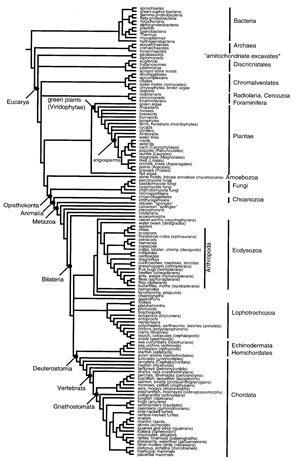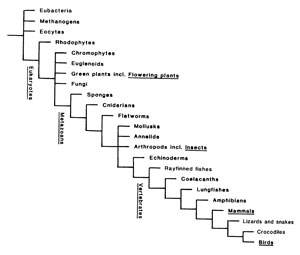A Teachable Tree
The Tree of Life will need to be displayed to different levels of detail for different audiences. Much research has focused on ways to visualize or navigate tree and graph data structures, assuming that all nodes are equally important. Here we seek to pull together work that serves as a foundation for conceptually telescoping the tree display.
click to enlarge or reduce screenshot

A presentation of the Tree of Life attemtping to compile the work conducted by various groups for the book, Assembling the Tree of Life. This book captures the state of knowledge at the beginning of the NSF Tree of Life initiative.
This diagram is included here to demonstrate how far there is to go to create a teachable tree. This diagram is olready a summary, although it would probably be overwhelming for public or high school audiences. There are possibly four recognizable words: "green plants" "Animalia" 'Bacteria' and "Fungi". Maybe.
Notable features of this tree visualization: The length of the lines is soley functional, being as long as they need to be to draw the tree structure with all leaf nodes lined up. Two different ways to label important nodes or clades are shown here: labeled circles and labeled vertical lines. All but one label is a scientific name. (open big version in new window)
As a public service, the Tree of Life project should produce a teachable, distinguishable structure that is a summary of the entire tree. Interacting with this tree structure online should allow one to leap from one noteworthy branching distinction to another. This "telescoping" precludes the need to travel all of the numerous nodes in between. Linnean ranks such as Species, Genus, Family, Order, Class, Phylum, Kingdom have previously indicated noteworthy distinctions, but having been applied differently within different disciplines of Biology, are no longer serving us well across the whole tree.
click to enlarge or reduce screenshot

A diagram summarizing the tree above, again from the book, Assembling the Tree of Life. This is simpler, and has a few more common names. Again, the length of the lines doesn't have meaning. People who know they are mammals will probably be able to find themselves on this visualization of the tree, although they might be at a loss to tell what the take-home message is.
With computers to organize & access data, we can now replace the Linnean rank system with expert-selected indices. These indices can also scale for the given audience involved, just like we often drop out Linnean ranks if inappropriate for a given audience.
Technologically, this might be represented with Degree-Of-Interest functions on tree-structures. Current work assigns Degree of Interest by what a user has interacted with or searched for. Visualization techniques then emphasize these parts of the tree-structured data that the user has interacted with, using a technique known as focus-plus-context.
In the context of presenting the Tree of Life data through a web application, authoritative Degree-Of Interest patterns could pre-exist, shaping to which degree of detail various audiences view the tree. The expert research committees in charge of their respective branches of the tree of life would publish these authoritative Degree Of Interest Indices that would essentially define the telescoping pieces, designating the branching points that are noteworthy for various audiences.
When a user comes to interact with the online web application providing access to the tree of life, they start with a view of the tree appropriate to their audience category, created from these authoritative indices. As they navigate the tree, their choices create a Degree of Interest function that interacts with the authoritative index to display appropriate parts of the tree. As the user requests more specific information, they will see more detailed views of the tree, untelescoping it and encountering these parts of the tree as a different type of audience. For example, the high school biology student might see most of the tree as the public would, but see more detail in the Primates, where her research is focused on writing a paper for class.
Teachers might define their own filters on the authoritative Degree-of-Interest Indices, indicating which branching points are covered in the curriculum of a given course.
While there are many nodes in the Tree of Life, not all of them are named. By naming a node, a scientist indicates that this grouping needs to be referred to in further work. A first pass at generating an index on the Tree of Life might be the named nodes, although the resulting index targets the researchers themselves, not members of other audiences.